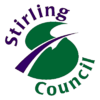Stirling (council area)
| Stirling Sruighlea Stirlin | |||
|---|---|---|---|
| |||
 | |||
| Admin HQ | Stirling | ||
| Government | |||
| • Body | Stirling Council | ||
| • Control | Lab + Con (council NOC) | ||
| • MPs | |||
| • MSPs | |||
| Area | |||
| • Total | 844 sq mi (2,187 km2) | ||
| Area rank | Ranked 9th | ||
| Population (2010 est.) | |||
| • Total | 90,000 | ||
| • Rank | Ranked 23rd | ||
| • Density | 110/sq mi (41/km2) | ||
| ONS code | 00RG | ||
| ISO 3166 code | GB-STG | ||
| Website |
www | ||
The Stirling council area (Scots: Stirlin, Scottish Gaelic: Sruighlea) is one of the 32 council areas of Scotland, and has a population of about 91,000 (2012 estimate).[1] It was created under the Local Government etc (Scotland) Act 1994 with the boundaries of the Stirling district of the former Central local government region, and it covers most of the former county of Stirling (except Falkirk) and the south-western portion of the former county of Perth. Both counties were abolished for local government purposes under the Local Government (Scotland) Act 1973.
The administrative centre of the area is the city of Stirling.
The area borders the council areas of Clackmannanshire (to the east), North Lanarkshire (to the south), Falkirk (to the south east), Perth and Kinross (to the north and north east), Argyll and Bute (to the north and north west), and both East and West Dunbartonshire to Stirling's southwest.
The majority of the population of the area is located in its southeast corner, in the city of Stirling and in the surrounding lowland communities: Bridge of Allan and Dunblane to the north, Bannockburn to the immediate south, and the three former coal mining communities of Cowie, Fallin, and Plean, known collectively as the "Eastern Villages".
The remaining 30 percent of the region's population is sparsely distributed across the rural, mainly highland, expanse in the north of the region. The southern half of this rural area comprises the flat western floodplain of the River Forth, bounded on the south by the Touch Hills and the Campsie Fells. North of the glen lie the Trossachs mountains, and the northern half of the region is generally mountainous in character.
The Council
As with all local authorities in Scotland, Stirling Council has a number of multi-member wards electing representatives under the single transferable vote system.
| Party | Councillors | |
| Scottish National Party | 9 | |
| Labour | 8 | |
| Conservative | 4 | |
| Green Party | 1 |
The wards and their councillors are:
- Bannockburn (3 Councillors): Margaret Brisley (Lab), Alasdair MacPherson (SNP), Violet Weir (Lab)
- Castle (3 Councillors): Johanna Boyd (Lab), John Hendry (Lab), Jim Thomson (SNP)
- Dunblane & Bridge of Allan (4 Councillors): Callum Campbell (Con), Graham Houston (SNP), Mike Robbins (Lab), Mark Ruskell (Green)
- Forth & Endrick (3 Councillors): Alistair Berrill (Con), Graham Lambie (SNP), Ian Muirhead (SNP)
- Stirling East (3 Councillors): Danny Gibson (Lab), Corrie McChord (Lab), Gerry McLaughlan (SNP)
- Stirling West (3 Councillors): Neil Benny (Con), Scott Farmer (SNP), Christine Simpson (Lab)
- Trossachs and Teith (3 Councillors): Martin Earl (Con), Alycia Hayes (SNP), Fergus Wood (SNP)
Settlements

As well as the city of Stirling itself, there are many towns, villages and hamlets spread across the council area:
Towns
Villages
- Aberfoyle
- Arnprior
- Balfron
- Balmaha
- Balquhidder
- Blairlogie
- Blanefield
- Buchlyvie
- Cambusbarron
- Cambuskenneth
- Cowie
- Crianlarich
- Croftamie
- Deanston
- Drymen
- Fallin
- Fintry
- Gargunnock
- Gartmore
- Killearn
- Killin
- Kinlochard
- Kippen
- Lochearnhead
- Plean
- Port of Menteith
- Strathblane
- Strathyre
- Thornhill
- Throsk
- Tyndrum
Hamlets
- Ardchullarie More
- Ardchyle
- Ardeonaig
- Ashfield
- Auchlyne
- Balfron Station
- Boquhan
- Buchanan Smithy
- Carbeth
- Clifton
- Dalmary
- Gartness
- Kilmahog
- Kinbuck
- Milton
- Mugdock
- Ruskie
Places of interest
- Carse of Lecropt
- Culcreuch Castle
- Inchmahome Priory (a ruined Augustinian priory on an island in the Lake of Menteith, used as a refuge in 1547 by Mary, Queen of Scots)
- Breadalbane Folklore Centre
- Cambuskenneth Abbey (formerly the seat of the Scottish Parliament)
- Doune Castle
- Falls of Dochart
- Falls of Lochay
- Glen Dochart
- Glenfinlas
- Lake of Menteith
- Lecropt Kirk
- Loch Achray
- Loch Ard
- Loch Earn
- Loch Lomond and the Trossachs National Park
- Loch Katrine (The source of most of the drinking water for the city of Glasgow)
- Loch Rusky
- Loch Venachar
- Moirlannich Longhouse
- Queen Elizabeth Forest Park (run by the Forestry Commission)
- Scottish Institute of Sport (on the grounds of Stirling University)
- Stirling Castle
- The University of Stirling
- The Trossachs
- Wallace Monument
- West Highland Way
References
- ↑ National Records of Scotland. Stirling Council Demographic factsheet. 2012 Estimate of population. Retrieved 18 Sept 2013
External links
| Wikimedia Commons has media related to Stirling council area. |
- Stirling Council official website
- Stirling (council area) at DMOZ
Coordinates: 56°30′00″N 4°00′00″W / 56.5000°N 4.0000°W

